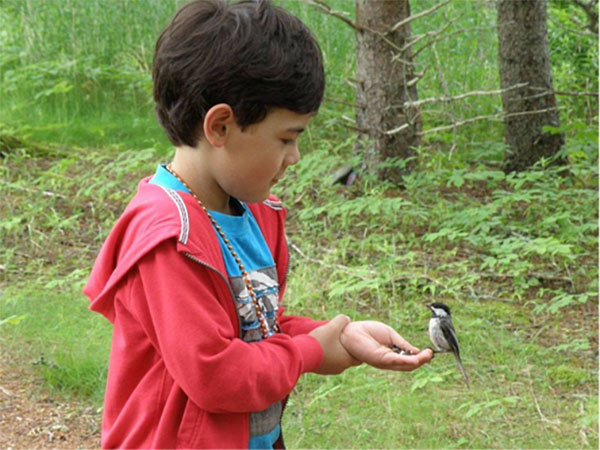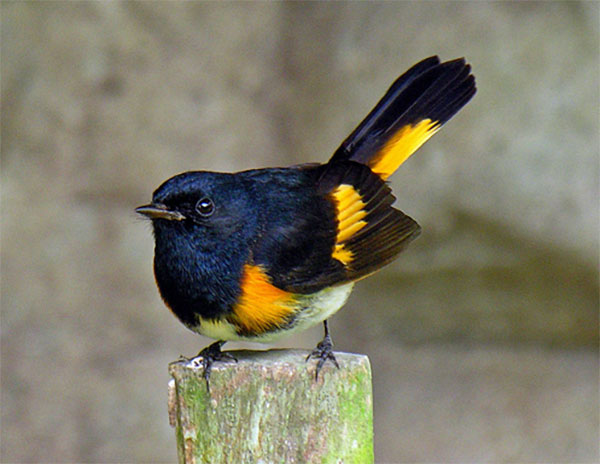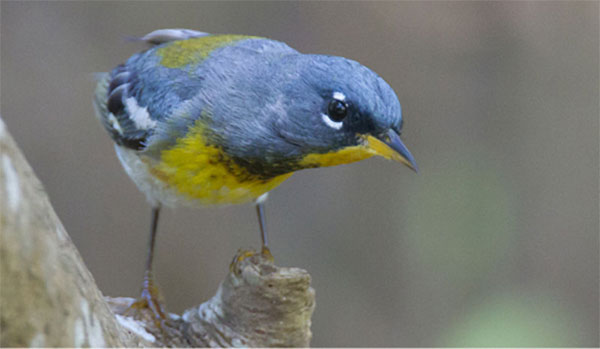
This section of Le Petit Bois is one of the best places on campus to go bird watching or to just sit quietly and listen to bird song from the forest canopy overhead. Throughout the warmer seasons, these woods are filled with many different species of birds, including the Black-capped Chickadee, the Red-eyed Vireo, the American Robin, the American Goldfinch and the Song Sparrow.
There are warblers in abundance here. These are brightly coloured birds, usually bearing patches of yellow, blue, red or orange in their plumage. They are usually smaller than sparrows and have needle-thin beaks adapted for catching insects. From spring to fall, they live here in Nova Scotia. In the autumn these birds go on an epic journey, migrating south to warmer climates, some as far as Florida, California, Mexico, Nicaragua, Peru, Brazil and the West Indies.
The American Redstart

The American Redstart (Setophaga ruticilla) is only 11 to 14 cm in size (that’s approximately 4½ to 5½ inches tall). The male is coal-black with vivid orange patches on its sides, wings, and tail. He is active and animated – a ‘bird in a hurry’ – with a sweet song of rapid high-pitched notes. The females are grey rather than black with more muted yellow patches. She builds the nest, usually in the fork of a tree or in leafy shrubs, using plant fibers, grass, lichens and birch bark, and lays between 2 and 5 eggs each season.
While hunting for food, the Redstarts flash the vivid colour patches on their wings in order to startle insects into flight. They make an annual migration south for the winter, travelling to the Caribbean, Mexico, Central America and the northern countries of South America.
The Northern Parula

The Northern Parula (Setophaga Americana) has a pale blue-grey back, a bright yellow belly and two white bars on its wings. The female and juvenile birds have more subdued colouring than the males. They are even smaller than the Redstart, at 11 to 12 cm (about 4¼ inches to 4¾ inches) in size. The Northern Parulas feed mainly on spiders and insects such as caterpillars. These tiny birds migrate south for the winter months to Mexico and the islands of the Caribbean. The Northern Parulas tend to nest in forests where there is abundant lichen for their nests.
The Downy Woodpecker

Not all of the birds in Le Petit Bois go south for the winter. The Downy Woodpeckers (Dryobates pubescens) live here year round. These birds are the smallest of our woodpeckers (14 to 17 cm or 5½” to 6½”) and make their nests in cavities excavated in dead trees. The opening to the nest is circular and less than 5 cm across (2”). Their heavy coat of down helps to protect them from the winter cold. It is easy to know when woodpeckers are nearby: you can hear the drumming they make while pecking at the bark of trees. Scientists calculate that the impact force of their pointy bills hammering against trees is equal to 1000 times the force of gravity. Studies of the bone and muscles in their skulls reveal that these birds have special muscles that protect their brains from damage. They eat mainly insects, but also feed on seeds and berries.
In 2017, Le Petit Bois’ bird interpretation will be augmented when the lighthouse interpretive galleries and bird-banding laboratory open for the public.

